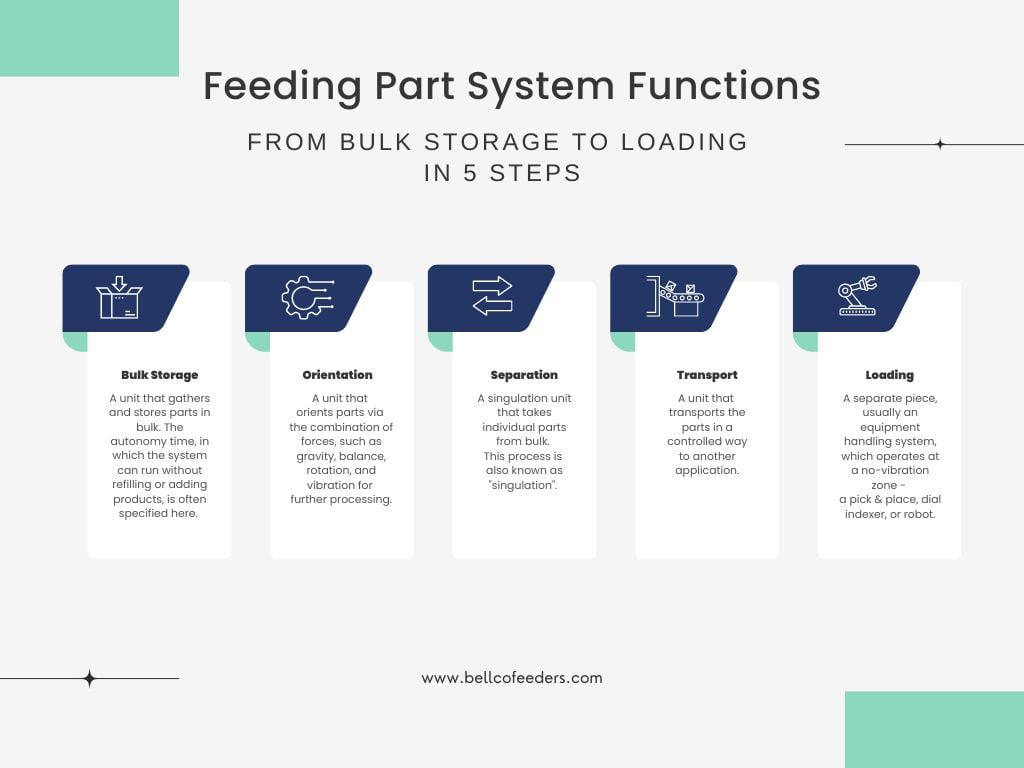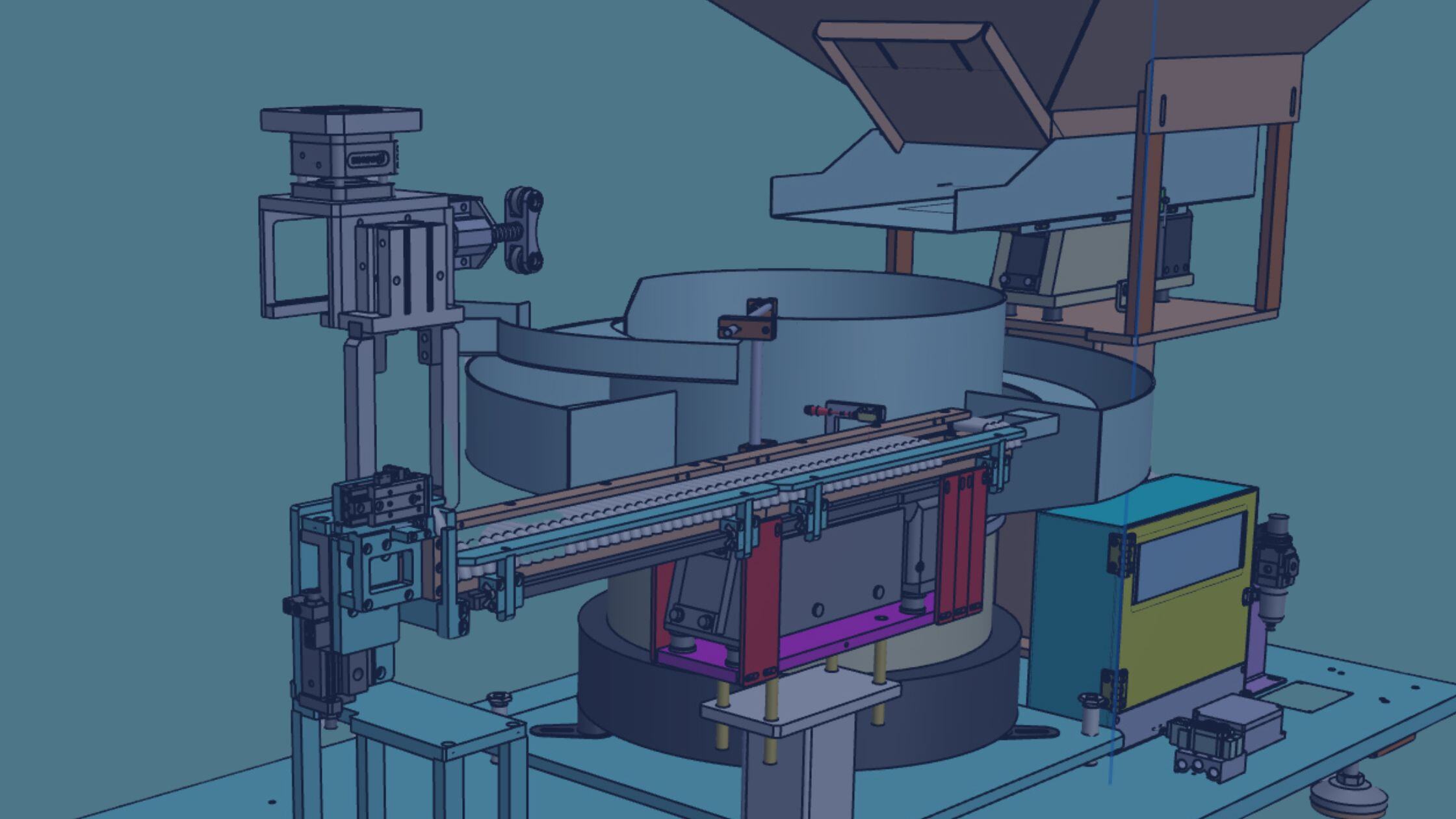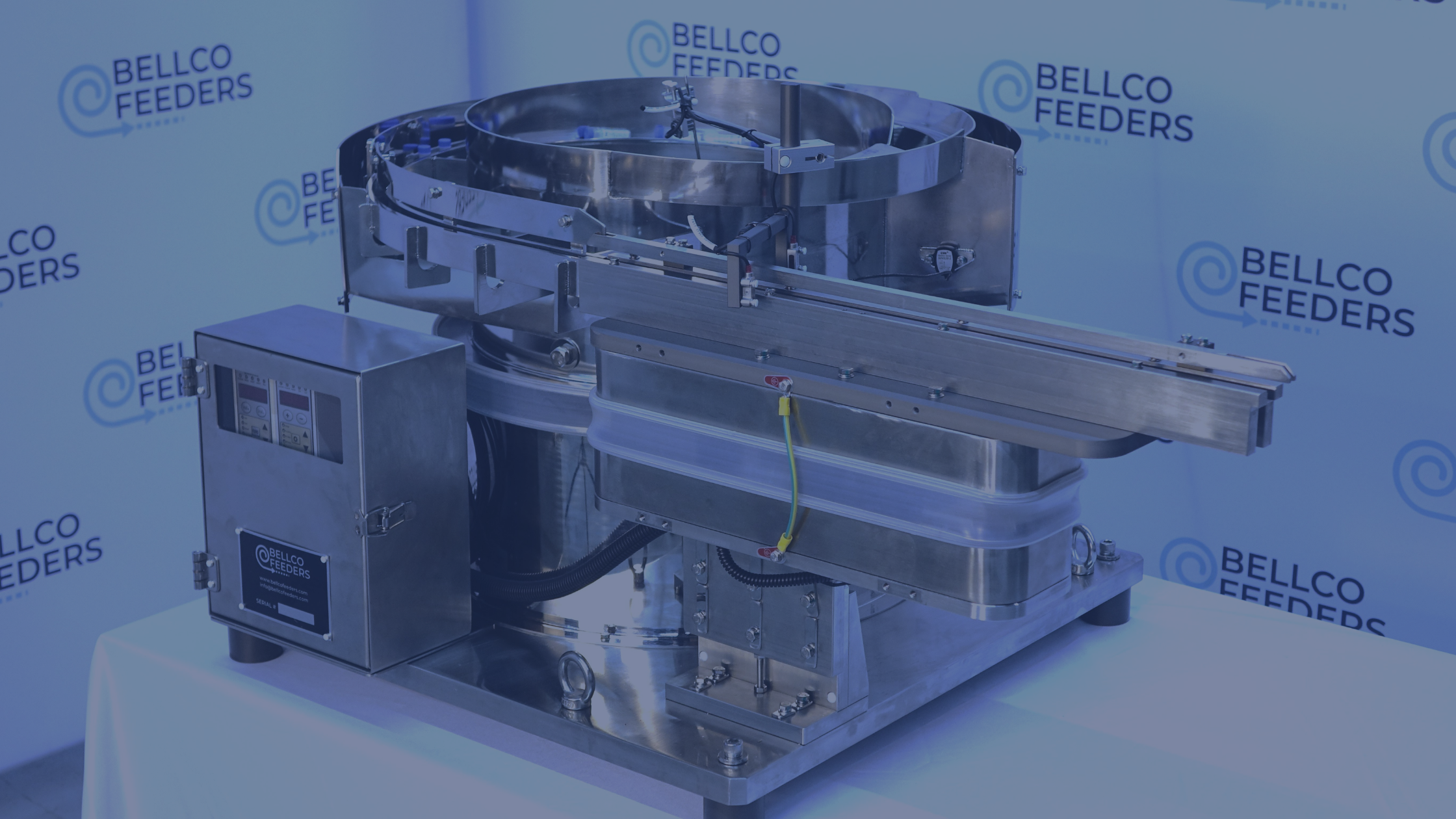Understanding Vibratory Bowl Feeders: Definition, Functions + Benefits
Processing and manufacturing industries are constantly evolving to meet customers' requirements. To keep processes current, manufacturers can easily integrate vibratory feeders into their applications to optimize production processes and receive a cost-effective alternative to manual labor. These mechanical devices are relevant to all industries, including consumer products, medical, pharmaceutical, automotive, electrical components, aerospace and aviation, beverage and food, and others.
In this post, we will define vibratory bowl feeders, show how they work, and discuss their types, applications, and benefits. These aspects will provide you with the best practices for getting started with vibratory bowl feeders in your company.
What is a Vibratory Bowl Feeder?
A vibratory bowl feeder is a type of feeding system that utilizes vibration to handle small parts from bulk and sort and orient them for industrial production lines. It enhances workplace safety and increases speed, consistency, and accuracy. You can use bowl feeders for screws, caps, bolts, and other parts of various geometries, weights, and materials.
Vibratory bowl feeders are often used with other production equipment and work best in a process line with an automated filling or packaging machine. You can save even more time when you integrate them with pick-and-place robots, grippers, camera systems, PLC systems, and other hardware.
What Are the Functions of a Vibratory Bowl Feeder?
Many processes in the industrial industry require continuous feeding, where machine connections must be consistent and synchronized to maximize efficiency. Feeding part systems have the following functions:

Bowl feeders are a positioning unit and offer a cost-effective and optimal solution as they eliminate the possibility of human errors and reduce production downtime. The bowls receive bulk parts to be oriented and transferred in a certain way and at the rate requested by the customer.
Fundamentally, a vibratory feeder bowl consists of a bowl-shaped container with spiral tracks positioned inside. In the first stage of the process, parts are loaded into the bowl from a bulk container and shaken by vibration sequences to move them up through the tracks. Components will gradually align themselves as they move forward along the tracks on the inside of the bowl. Any pieces that are not perfectly oriented will drop from the tracks and land back in the bowl.
Components
Hoppers
The hopper is the area that stores parts before their transportation to the feeder bowl. Its level control switch can ensure no overload or shortage of parts in the bowl. Signals from level control switches activate hoppers automatically.
Bowl Feeder Diameter
The bowl feeder's diameter is the most crucial aspect of its design. Devices must be tailor-made to the materials they will convey. The diameter should be ten times the part’s length that will join the bowl track.
The accurate diameter of the bowl is essential to orienting parts properly and achieving high speeds. The bowl feeder selection and design process require the assistance of an experienced engineer and manufacturer. Otherwise:
- If the bowl diameter is overly big, the bowl will not operate, and parts will bounce. Positioning and correct feeding will not happen.
- If the bowl diameter is overly small, this will exceed the drive unit's capacity.
Base/Drive Unit
The drive unit is the system's powerhouse, and you can choose it according to the parts' materials and their size, mass, and amount in the bowl. It uses electromagnetic energy to produce vibrations that shake and move the parts. The typical vibration range is between 60 and 120 Hz.
Linear feeder
Linear feeders collect and present parts to an operator or another automated system. Their purpose is to move them along so they can exit the bowl. There are four linear feeders: conveyor, vibratory, airveyor, and gravity.
Feeding Rate
The feeding rate refers to the amount of parts transferred over a fixed time period. It leans on the parts' configuration, positioning needs, the number of tracks, and the unit size. The examination is an essential part of the process, and you should inspect six factors to control the feeding rate:
- Part dimensions - size, geometry, etc.
- Part materials - they influence the wear features and coefficient of friction.
- Weight - The parts' weight and gravity center will impact their position.
- Orientation - a fundamental activity of bowl feeders; it highly impacts the feed rate.
- Process - Knowing all characteristics helps the integration process of the feeding system into another assembly if needed.
- Part Condition - Is the part greasy, soggy, or dirty? These conditions all have a dramatic effect on the feed rate. Firm and parched parts are easy to process, whereas the stamped and lubricated ones require thorough preparation because they stick to bowl feeder walls.
Feeder Bowl Level Control
Feeder bowls will only function if they have the correct number of parts in the bowl. If there are too many, they might bump into each other and get ruined, while a small amount will slow down the whole production process.
Sensors keep track of how many components are in the bowl. The level control switch on the hopper is another feature that helps with feeder bowl level control and automatically distributes them. When the feeder bowl empties, the vibrations will become more pronounced. Due to the high amplitude, such a condition can limit feed rates.
Amplitude Controller
Amplitude Controllers maintain a constant vibration speed and compensate for changes in the feeder cycle rates for hoppers, linear feeders, drive units, and rolls. The bowl feeder will run at its maximum output without a controller, necessitating the use of a variable rate controller to reduce vibrations.
Amplitude controllers implement counter-electromagnetic field (EMF) and infrared feedback for motor speed stabilization. The reduction in motor starting current prolongs the lifecycle of the motor and semiconductor.
Sound Reducing
When parts move in the part feeding system, they cause loud noise in the manufacturing environment. Workers are often required to wear hearing protection, such as noise-reduction safety ear muffs. Manufacturers may consider adding sound enclosures, in this case, to decrease sound levels and improve the workplace. Isolating materials also protect the parts.
Why Do I Need to Use a Bowl Feeder?
In automation and materials handling processes, bowl feeders play a crucial role in organizing and singulating bulk samples of parts. Their main advantages are improving manufacturing efficiency and helping reduce labor costs. However, using bowl feeders, customized per any industry's requirements, can result in more benefits, such as:
- Feeding and positioning parts with little to no effort from operators
- Automating manual labor and providing a continuous flow
- Precise parts counting, customized to their quantity, geometry, material, and size
- Integrate camera systems to detect and examine the pieces during the feeding process
- Integrate a pick-and-place robot for a final orientation of small components
Which Industries Can Benefit from Integrating Bowl Feeders in Their Applications?
For many industries relying on feeding part systems to improve productivity and assembly, bowl feeders have become crucial automation devices. A wide array of production processes uses bowl feeders because of their easy integration and operation, which makes them the perfect choice for speeding up production.
Consumer Products
Automation is a crucial strategy for fast-moving consumer goods (FMCG) companies to overcome challenges and take advantage of market opportunities.
Medical & Pharmaceutical
Using bowl feeders in the manufacturing process of medical & pharmaceutical devices can help ensure their quality and accuracy meet industry standards.
Automotive
With the increasing popularity of electric vehicles (EVs), battery technology advancements, and customization, automotive manufacturers must become more flexible. Feeding part systems can help them drive innovations faster in the automotive sector.
Electrical Components
Assembly automation is especially beneficial in electronics manufacturing. With the shrinking size of components and circuits, products become more complex. With proper design and customization, feeding part systems can handle small pieces.
Aerospace and Aviation
A demanding industry such as aerospace must embrace automation. The automated aircraft production process can also reduce errors and scrap rates while repurposing and focusing the production team’s attention on more business-critical tasks rather than just repetitive ones.
Food & Beverage
As a result of the food and beverage industry's ability to accelerate processes and maintain consistency throughout their product lines, businesses gain a competitive advantage through automation solutions, such as bowl feeders.
What Types of Bowl Feeders Are on the Market?
There are several bowl feeder types, depending on their design, movement, and material. Parts processing varies depending on the rate and singulation requirements, and vibratory, centrifugal, conical, and custom bowl feeders are available.
Vibratory Bowl Feeders
Vibratory bowl feeders are one of the most familiar types when you search on the internet. The parts in the bowl move thanks to the vibrations of a drive unit. Vibratory bowl feeders rarely need upkeep, but if they move oily and wet parts, they may need regular cleaning.
Centrifugal Bowl Feeders
Centrifugal or rotary bowl feeders can handle plastic, rubber, or metal parts with more demanding and complex geometry at high speeds. They are an ideal solution for components that don't need orientation or other manipulation. While utilizing the centrifugal force, the pieces move in a circular motion toward the outline of the conical disk. The device can handle thousands of parts per minute quietly, with no vibrations.
Canonical Bowl Feeders
Conical bowl feeders are vibratory bowl feeders with cone-shaped bowls. When specific angles are required to feed the pan, parts are placed on the inside wall to decrease part movement and corrosion. Components can have simple geometry and an open hollow design for applications in the medical, pharmaceutical, and food industries.
Custom Bowl Feeders
What makes bowl feeders a great solution is that they can fit into any manufacturing process and optimize it. It is essential to tailor bowl feeders to the unique conditions and requirements of the client before integrating them into an application. Bowl feeder manufacturers examine and design every detail of the feeding system to fit your production type effectively. It is recommended that you choose a partner that will offer you further on-site support with a dedicated team and proactive customer service.
Bowl Types, Materials, and Track Configurations
The bowl feeder's main attribute is the bowl, and its size and shape are crucial for handling the parts. You can choose from cylindrical, stepped, conical, polyamide, and outside track bowls according to your components' geometry, size, and type.
Types of Vibratory Bowl Feeders
Cylindrical bowl
Cylindrical bowls come with low-priced assembly and tooling. They handle the part orientation on an exterior track, which improves the process. Cylindrical bowls have a restrictive capacity, and manufacturing experts recommend them for feeding small parts.
Stepped bowl
Thanks to the wide feeding track, components are pre-oriented easily. The stepped bowl's bigger size stops part jamming in the feeder.
Conical bowl
Compared to cylindrical bowls, conical bowls have a larger capacity, a larger diameter, an increased number, and wider tracks.
Polyamide bowl
The plastic material of polyamide bowls enables parts to slide more easily and prevents the problems that come with steel. Due to the plastic features, polyamide bowls are more flexible and have increased sound reduction.
Outside track bowls
Outside track bowls are for operations with strict part singulation, orientation, and a higher speed rate with several lines. The track's angle is descending, which helps parts split quicker and add to the internal bowl.
What materials are vibratory bowls made of?
Cast aluminum, plastic, some classes of steel, and stainless steel are the typical materials for manufacturing bowls.
Track configurations are available for vibratory bowl feeders?
The parts' shape determines the angles and the types of track configuration: negative, hi-negative, positive, multiple, radius, and v-shaped.
- Negative tracks. The angle between the bowl's side wall and the track is greater than 90°. It usually orients parts, such as thin rectangular stampings and shallow cap or pan kinds of parts.
- Hi-Negative tracks. The angle is 60° in the last bowl feeder's quarter. Typical parts for these types of tracks are nonuniform, asymmetrical, or have a projection on one side.
- Positive tracks. The angle between the track and the bowl's side wall is less than 90°.
- Multiple tracks. The vibratory bowl has two or more tracks, which carry parts to the discharge. Benefits include higher production rates and the simultaneous delivery of set numbers of components.
- Radius tracks. They have a hollow for the whole track length but some just for the last quadrant. Typical parts are cylindrical, whose length is equal to or greater than its diameter.
- V-shaped tracks. They are also for cylindrical components and have a hollow of different angles of 60°, 90°, 120°, or 150° according to the parts' type and diameter.
Conclusion
Consider several factors when selecting a vibratory bowl feeder, including the industry, application, material properties, geometry, and product volume. Research and get an informed opinion about how to choose the right vibratory bowl feeder components from engineers who are experts in this field.
- Part orientation - The bowls manage the parts' correct position before they get to the assembly station.
- Base Unit - Vibratory drive units must be selected based on the equipment and assembly required.
- Bowl Diameter - A bowl's diameter should be at least ten times the length of the part it is to orient and position.
- Bowl Capacity - Install a hopper and a level control switch to maintain the optimum part level. Consider the parts' weight and desired feeder's speed rate.
- Feed Rate - The rate at which correctly oriented parts are discharged from the bowl. The Parts Per Minute (PPM) rate depends on the parts' mass, the amount of required orientation, the number of bowl tracks, the base unit size and type, the capacity, the controller, and other accessories.
- Correct Controller - it controls the feeder drive units. It is capable of both basic and advanced vibratory feeder operation.
To ensure maximum worker safety and cost-efficiency, choose part feeding systems. They provide investment security due to the long product cycle and availability of spare parts. You can easily integrate them into your applications and stay competitive and productive in your market.



